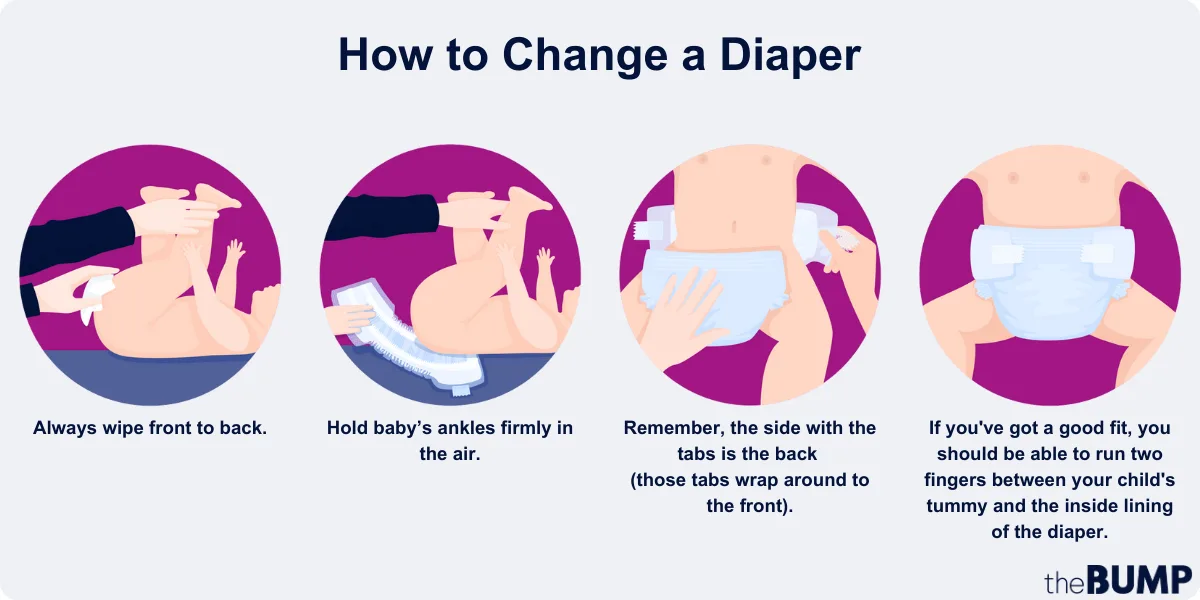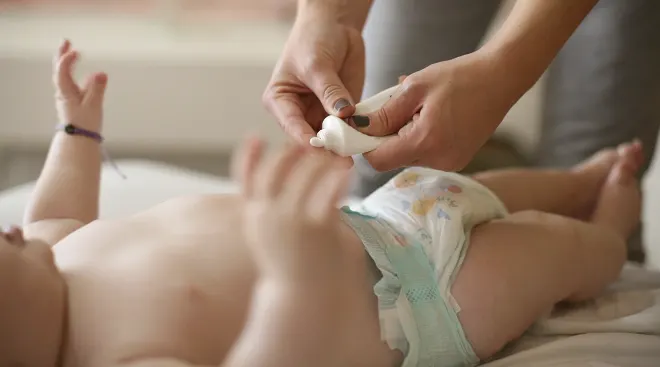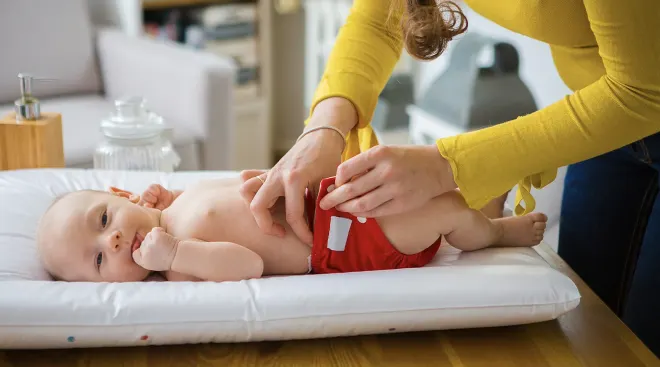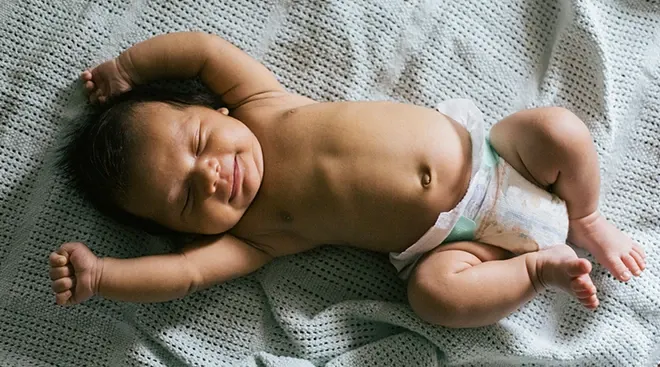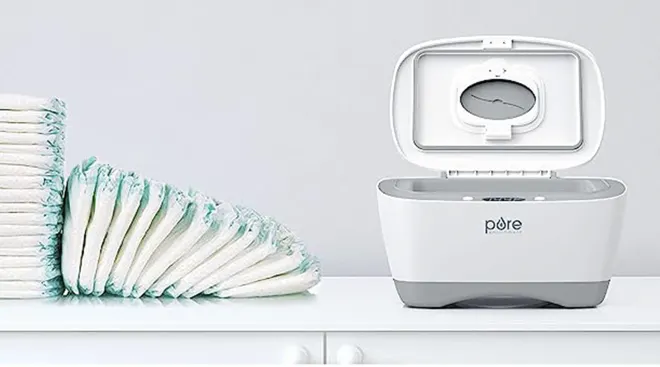Step-by-Step Instructions for How to Change a Diaper
Diaper changes are an inevitable part of the whole parenting gig. And it’s one of the tasks you’ll master early on—even if you’ve never touched a diaper before now. Practice makes perfect, and you’re about to be in the throes of it. According to the American Academy of Pediatrics (AAP), baby will go through nearly 8,000 diapers before graduating to the potty.
Stressing over how to change a diaper? Rest assured that soon enough, you’ll have your own tried-and-true method for getting the job done quickly, efficiently and with minimal mess. “You’re going to do this 10 to 12 times a day, and you’ll be an expert in two days,” says Jada Shapiro, a birthing and postpartum doula and founder of Boober, a marketplace that connects parents to classes and care providers. Still, it’s good to have some tips in your back pocket before you’re dealing with your first 4 a.m. diaper change. Ready to get a grasp on the basics? Here’s what you need to know about learning how to change a baby’s diaper.
Ready to get your hands dirty (so to speak)? Here’s the basic step-by-step rundown of how to change a baby’s diaper.
- Step 1: Wash your hands with soap and warm water.
- Step 2: Lay baby down on a clean, dry and safe area. You might consider placing a blanket or disposable pad on top of your changing surface to make the spot more comfortable and keep cleanup to a minimum. Make sure everything you need is within arm’s reach. “If your child is on an elevated surface, keep a hand on baby at all times to prevent falls,” advises Whitney Casares, MD, a board-certified pediatrician and the founder of Modern Mommy Doc. “When babies are changed on elevated surfaces without proper supervision, they can fall easily, leading to serious head and neck injuries.”
- Step 3: Remove and dispose of the dirty diaper. Take care to hold baby’s ankles firmly in the air; if there’s a poop, use the dirty diaper to wipe off any excess. “You want to keep a grip on the ankles because when there’s poop, if you drop a foot in it, then that might hit the wall or your shirt, and then you have a problem,” says Shapiro. Quickly dispose of the diaper, making sure you have your receptacle of choice nearby and open.
- Step 4: Use wipes to clean baby. Make sure to go from front to back when wiping poop, pee or debris. “Don’t forget all the little creases and crevices; you’ll want to lay the baby’s legs down, because poop and pee can get stuck in the thigh folds,” says Shapiro. “And if baby has a vagina, you also want to gently spread the labia and get into those creases, especially if there’s a poop.”
- Step 5: Dry baby well. You can use a cloth to gently pat or fan the area dry. “The reason it’s so important to get this area dry is that moisture locked inside the diaper is what leads to diaper rash,” says Shapiro. Apply diaper cream or ointment to any sensitive areas, as needed.
- Step 6: Get the new diaper ready. Get out a new diaper and open it—the side with the tabs is the back (those tabs wrap around to secure in the front). A good visual clue? If the diaper has a picture, it tends to be on the front. When the diaper is unfolded, there’s a natural crease in the middle. “Slide the diaper under baby so their bottom goes right into that diaper crease,” says Shapiro.
- Step 7: Put on the new diaper. Open baby’s legs and pull the front part of the diaper between their legs and up; then bring tabs to the front of the belly and fasten. “Make sure the diaper is snug to your baby’s skin but not too tight or too loose. If the fit is right, you should be able to run two fingers between your child’s stomach and the inside lining of the diaper,” notes Casares. “Watch closely for indentations or marks around baby’s legs or waist. If you notice these, it may be time to change to the next diaper size.”
- Step 8: Put baby in a safe place. If you have been using an elevated changing surface, now is a good time to return baby to their carrier, crib or a designated safe play space.
- Step 9: Clean up. Don’t forget to clean the changing surface and wash your hands again. You should also clean baby’s hands if they’ve gotten into their diaper area. (Little hands will wander!)
Babies tend to need a fair amount of stuff, but diaper-changing essentials should be at the top of your must-have list. Here’s what you’ll want to have on hand before you bring baby home:
-
Changing pad (with cover, if needed). Some changing pads are made of molded plastic so they can easily be wiped down after each use, while others are more cushioned and require separate covers. Of course, you can also opt to change baby on a mat or another soft, safe surface. It’s a matter of preference and comfort level.
-
A diaper-changing surface. A changing table is helpful but not necessary. You may even feel more comfortable changing baby on a couch or rug. “I think the best place to change any child is on the floor, on a portable changing pad you can just wipe clean,” says Melissa J. Goldstein, MD, a pediatrician at Carnegie Hill Pediatrics in New York City. “It’s hard to reach for the different things you need when [baby is] on a table and still be holding them carefully. As they get older, they get more purposefully wiggly, so it becomes all the more important to not have that added risk of falling off the changing table.” If you do choose a changing table, make sure to keep one hand on baby at all times—even if the table has a strap or a railing.
-
Diapers. Some parents prefer disposable diapers, some opt to use cloth diapers and diaper covers. You also don’t have to choose between the two styles—you can use a combination of both. Either way, make sure you’re prepared with plenty of newborn sizes for those early days.
-
Baby wipes. FYI, wipes aren’t just for cleaning poop. You’ll still want to give baby a good wipe down if they’ve been marinating in a pee-filled diaper.
-
Diaper cream. Use diaper cream or ointment when baby’s bottom is looking a little red and rashy. Better yet, apply it proactively at each diaper change to prevent irritation in the first place.
-
Diaper pail. You can choose to get a designated diaper pail and liners, but a small lidded trash can with garbage bags will also do the trick.
-
Cloth diaper inserts or washcloths. As a new parent, you’ll be amazed at how often a clean washcloth comes in handy. “Even if you aren’t using cloth diapers, you can use the inserts, which are super soft and absorbent, for wiping spills and covering baby’s penis to protect yourself from unexpected pee,” says Shapiro.
-
Toys to distract baby. Some parents and caregivers find it helpful to have a few novel items that only get brought out during diaper-change time.
-
Hand sanitizer. Ideally, you should wash your hands before and after each diaper change, but keeping a bottle of hand sanitizer near your changing station can be helpful.
So you’ve gotten the rundown on how to change a diaper—but the question remains, when to change a diaper? You should change baby whenever their diaper is wet or soiled. Goldstein suggests getting newborn diapers with a color-changing stripe that indicates when the diaper is wet. "In the first three to four days, you really aren’t getting many wet diapers, so we just look for that stripe,” she says. “It makes wet diapers much easier to identify.
Wondering how often to change a newborn diaper? Goldstein says to shoot for five to eight diaper changes a day. If you’re ever concerned that baby isn’t producing enough wet diapers, call your pediatrician; this could be a sign that baby isn’t getting enough to eat.
As baby gets older and starts eating more and soiling more diapers, changing them every three to four hours during the day is a good baseline. Basically, you just want to make sure that the area is clean and dry. “Watch for any signs of irritation if you happen to change diaper brands because babies may be more sensitive to one type of diaper or another,” advises Casares. “At the first sign of diaper rash, apply a barrier cream or ointment to prevent additional urine or poop from aggravating the rash.”
When to stop changing diapers at night
It’s one thing to change baby like clockwork during the daylight hours, but it’s quite another when you’re trying to get rest at night. So should you wake baby to change their diaper? The simple answer: not unless you enjoy sleep deprivation. “You certainly don’t want to wake a baby if they’re sleeping peacefully. If they poop, they’re going to wake up, and diapers are so absorbent that they can certainly sit with a bit of urine in their diaper during the time they’re asleep,” says Goldstein.
In the unlikely event they don’t stir after doing “number two” in a diaper in their sleep, you’ll want to calmly and quietly change them. Try to keep it dim and avoid too much stimulation. They’ll hopefully nod right back off once they’re clean and comfortable. Similarly, if baby still wakes to feed in the middle of the night, you can use this opportunity to change a diaper that feels particularly full or heavy with urine. Again, you’ll want to try to maintain a sleepy vibe.
Ready to get that first changed diaper under your belt? You’ve got this! But in case you don’t have it quite yet, here are a few tips to keep top of mind.
-
Distract, distract, distract. A mobile, a few unexpected toys or even some tunes playing from your phone can help keep baby entertained while you’re dealing with their diaper.
-
Fit it right. The good news is that today’s diapers have tabs that can easily be readjusted if you make them too tight or too loose. “The diaper shouldn’t be so tight that it’s cutting off circulation, but if it’s too loose you will see poop and pee leaking,” says Shapiro. With practice, you’ll come to know exactly how tight or loose to fasten it.
-
Watch for rolling. Babies typically begin to roll around the four-month mark. Regardless of baby’s age, you should never walk away from a changing table. Goldstein notes that "a newborn can absolutely kick over … it’s just not intentional.” Use caution and remain close.
-
Make it a bonding moment. Sometimes baby diaper changes feel like an all-business affair. But you can make this moment a little less transactional and a whole lot more enjoyable—for you and your little one. Talk softly, sing songs and give that cute belly a tickle.
How to change a newborn diaper
You might be intimidated by the idea of changing an itty-bitty, fragile newborn, but here’s the good news: At this age and stage, they don’t really squirm or resist. Still, here are a couple handy tips for how to change a newborn diaper:
-
Be careful of the umbilical area. If your newborn’s umbilical cord stump hasn’t fallen off yet, you can fold down the top of the diaper so it sits under their belly button area, which will make them more comfortable. Many newborn diapers are designed with a dip that contours around the stump.
-
Follow circumcision care instructions. If your newborn has been circumcised, follow your doctor’s instructions for diaper change care. Generally, you’ll want to keep the wound clean and lubricated until the scab heals. You may need to replace the gauze and reapply ointment during baby’s diaper changes.
How to change a boy’s diaper
If baby has a penis, they have what Goldstein calls “a tiny firehose.” And when it’s exposed to air as you open the diaper, be prepared (and maybe take cover). “They tend to pee far and wide,” says Shapiro. Getting sprayed is practically a rite of passage for new parents, but you can take steps to prevent this from happening. First, immediately cover the penis with a soft cloth (like a diaper insert or burp cloth) during baby boy diaper changes. “When you do this, also make sure the penis is pointing down, since the pee absolutely can come through the cloth and hit you,” says Goldstein. You’ll also want to return it to this position when you put on the clean diaper. “Point the penis down towards the feet before you close the diaper so they don’t pee on themselves, because that’s when they tend to leak the most,” says Goldstein.
How to change a girl’s diaper
There are generally no surprise soakdowns with girl diaper changes. One important thing to note: If you’re changing a baby girl’s poopy diaper, it’s especially important to clean them from front to back, wiping away from their vagina. "If you don’t wipe front to back, they’re at risk for a urinary tract infection,” explains Goldstein.
How to change a diaper on a toddler
As baby grows older, they may be less keen to stay put while you change their diaper. When aiming for a successful toddler diaper change, it’s important to remember the simple SLED acronym:
S for speed: Whatever changing method you choose to deploy, the key to quelling tantrums is to keep things as quick as possible. Have everything on hand and ready to go when it’s time to change.
L for location: Once baby is up and walking, it’s hard to keep them in one place. Switch things up and learn how to diaper them standing up so the fun can continue with minimal interruption.
E for empowerment: Toddlers are all about independence, so let them play a role in their diaper changes, whether that’s picking out the design on their diaper or fetching the wipes.
D for distraction: The key to a seemingly quick change is distraction (think books, toys, etc.). Have an older sibling around the house? Get them involved in the entertainment.
It may all seem daunting right now, but once you learn how to change a diaper, you’ll be amused that you were ever intimidated in the first place. Trust us, you’ll be an expert in no time.
Now that you’ve got the changing knowledge, do you know which diaper you’ll be reaching for? Pampers Swaddlers are the #1 best-selling diaper* for good reason—they’re ultra absorbent to help keep baby’s skin dry and healthy, and keep skin irritation away. Learn more at Pampers.com.
*Based on Nielsen dollar sales, L52W
Please note: The Bump and the materials and information it contains are not intended to, and do not constitute, medical or other health advice or diagnosis and should not be used as such. You should always consult with a qualified physician or health professional about your specific circumstances.
Plus, more from The Bump:
Whitney Casares, MD, MPH, FAAP, is a board-certified pediatrician, author, American Academy of Pediatrics spokesperson, and the CEO and founder of Modern Mommy Doc. She is the author of three books: The Working Mom Blueprint, The New Baby Blueprint and Doing It All. She earned her medical degree from the University of Vermont and completed her pediatrics residency at Stanford University in California.
Melissa J. Goldstein, MD, is a pediatrician at Carnegie Hill Pediatrics in New York City. She is also the co-founder of the Ready to Parent Lecture Series, a program that seeks to prepare new parents to bring newborns into their lives. She earned her medical degree at Cornell University Medical College in Ithaca, New York.
Jada Shapiro is a birth and postpartum doula, childbirth educator, lactation counselor and birth photographer. She is the founder of Boober, a marketplace that connects expectant and new parents to high-quality classes and on-demand, expert care providers like lactation consultants, doulas, mental health therapists and more. She graduated from Wesleyan University.
American Academy of Pediatrics, Changing Diapers, May 2021
Navigate forward to interact with the calendar and select a date. Press the question mark key to get the keyboard shortcuts for changing dates.

































